
Hiodontidae, commonly called mooneyes, is a family of ray-finned fish with a single included genus Hiodon. The genus comprise two living species native to North America and three to five extinct species recorded from Paleocene to Eocene age fossils. They are large-eyed, fork-tailed fish that superficially resemble shads. The vernacular name comes from the metallic shine of their eyes.
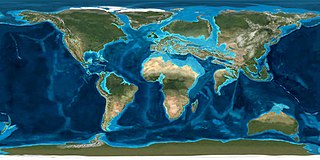
In the geologic timescale the Ypresian is the oldest age or lowest stratigraphic stage of the Eocene. It spans the time between 56 and47.8 Ma, is preceded by the Thanetian Age and is followed by the Eocene Lutetian Age. The Ypresian is consistent with the lower Eocene.

The moonfish of the genus Mene, the sole extant genus of the family Menidae, are disk-shaped fish which bear a vague resemblance to gourami, thanks to their thread-like pelvic fins. Today, the genus is represented only by Mene maculata of the Indo-Pacific, where it is a popular food fish, especially in the Philippines, where it is known as bilong-bilong, chabita, hiwas or tahas.
Foro panarium is an extinct bird of disputed taxonomic status that lived during the early to mid-Eocene around the Ypresian-Lutetian boundary, some 48 million years ago. F. panarium is known from fossils found in the Green River Formation of Wyoming.
Jefitchia is an extinct genus of prehistoric drum. Species lived from 48.6–33.9 mya . Jefitchia have been uncovered in Texas, Louisiana, and Portugal.

Dasornis is a genus of prehistoric pseudotooth birds. These were probably close relatives of either pelicans and storks or waterfowl; they are placed in the order Odontopterygiformes to account for this uncertainty.
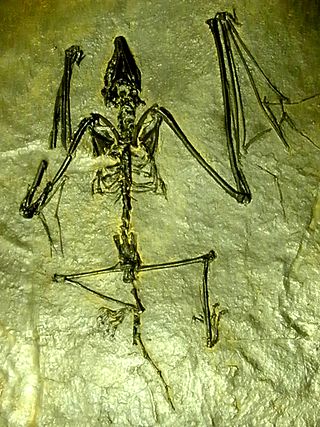
Archaeonycteris is an archaic bat genus whose fossilised remains have been found in Germany, France, England and India.
The Ieper Group is a group of rock strata in the subsurface of northwest Belgium. The group is subdivided into three marine formations, all formed during the Ypresian, a single age of the geologic timescale. Both age and group are named after the West Flemish town of Ypres, for which the Dutch name is "Ieper".

Amyzon is an extinct genus belonging to the sucker family Catostomidae first described in 1872 by E. D. Cope. There are six valid species in the genus. Amyzon are found in North American fossil sites dated from the Early Eocene in Montana and Washington USA, as well as the British Columbian sites at McAbee Fossil Beds, Driftwood Canyon, and the "Horsefly shale", as well as Early Oligocene sites in Nevada USA. One Middle Eocene species is known from the Xiawanpu Formation of China. The Ypresian species A. brevipinne of the Allenby Formation was redescribed in 2021 and moved to a separate monotypic genus Wilsonium.

Euphaeidae, sometimes incorrectly named Epallagidae and commonly called gossamerwings, is a family of damselflies in the odonate superfamily Calopterygoidea. The family is small, consisting of around 78 species living species in nine genera occurring in the Palearctic, Australasia, and Asia. The family contains two subfamilies, Euphaeinae, encompassing all the living species and a single fossil genus, and the extinct Eodichromatinae, encompassing fossil genera from the Eocene to late Oligocene. Euphaeid species are large and mostly metallic-coloured, looking similar to species of damselflies in the family Calopterygidae.

The Black Crow Limestone is an Early Eocene geologic formation in the Sperrgebiet, ǁKaras Region of southwestern Namibia. The limestones of the approximately 10 metres (33 ft) thin formation were deposited in a lacustrine to paludal environment. The formation provides many fossil mammals and amphibians, reptiles, fresh water snails and fish.
Saloumia is an extinct genus of the order Proboscidea. It is one of the oldest members of the order and lived in the middle Eocene of Senegal. It is known only from a single molar, whose pronounced bumpy chewing surface indicates it is probably closely related to Moeritherium.
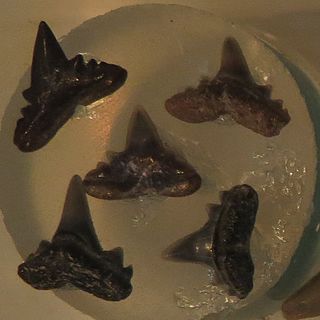
Abdounia is an extinct genus of requiem shark which lived during the Paleogene period. It is mainly known from isolated teeth. It is one of the earliest requiem sharks, and attained widespread success in North America, Europe, and Africa.

Xiphodolamia is a rare extinct genus of mackerel shark which lived during the Eocene epoch. It is only known from isolated teeth, but has been found in Europe, Africa, and Asia. It is assumed to be pelagic, occurring more frequently in deeper water deposits, most notably the London Clay and Eocene deposits in Denmark. It is distinguished by its rectangular root and twisted blade, unique among Mackerel sharks. It is unclear what niche this specialized dentition helped exploit.
Burnhamia is an extinct genus of devil ray from the Paleogene period. Due to superficial similarities, some species were originally mistaken for Cownose rays and placed in the genus Rhinoptera. It is known exclusively from dental batteries, mostly isolated teeth. There are several species attributed to this genus but their relation to each other is still unresolved. Some have proposed the type species B. daviesi arises in the late Paleocene and persists until the middle Eocene giving rise to the similar genus Eoplinthicus with an earlier offshoot leading to smaller and less ornamented species in the lower Eocene, namely B. fetahi. B. fetahi is known from Morocco and North America. B. daviesi was described from the London Clay Formation, but is well known from Eocene deposits throughout Asia, Europe, North Africa, and North America. However, teeth from the Claiborne Group of Alabama show teeth identical to B. daviesi coexisting with Eoplinthicus in the Bartonian. A Ypresian species, B. nessovi, known from a singular site in Kazakhstan was tentatively ascribed to the genus, though more material may show it warrant its own. B. crimensis is known from the Bartonian and Priabonian of Crimea.
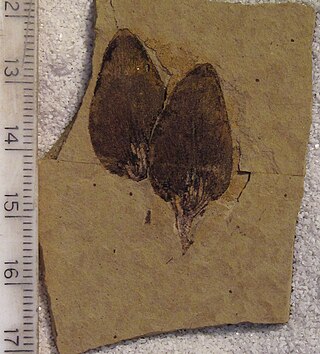
Pseudolarix wehrii is an extinct species of golden larch in the pine family (Pinaceae). The species is known from early Eocene fossils of northern Washington state, United States, and southern British Columbia, Canada, along with late Eocene mummified fossils found in the Qikiqtaaluk Region, Nunavut, Canada.
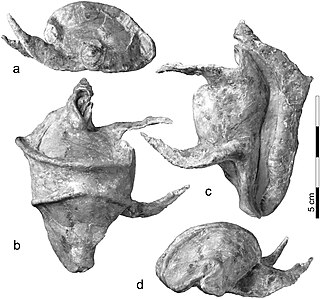
Vicetia is a genus of cowrie from the Eocene of Europe and Pakistan. Five species are currently recognized with all European forms forming a single anagenetic lineage progressively growing bigger and developing stronger ornamentation. The last known species, V. bizzottoi, is the biggest known cowrie known to science with a shell length of 33.5 cm. They were likely feeding on sponges or algae and went extinct following widespread climate change at the end of the Eocene, giving way for more derived lineages of cowries.
Tethylamna is an extinct genus of mackerel sharks that lived during the Eocene. It contains one valid species, T. dunni, and another potential species, T. twiggsensis. Its fossils have been found in North America, South America, Africa, and Asia. T. twiggsensis has also been assigned to Brachycarcharias.











